Related Research Articles

A comic strip is a sequence of cartoons, arranged in interrelated panels to display brief humor or form a narrative, often serialized, with text in balloons and captions. Traditionally, throughout the 20th and into the 21st century, these have been published in newspapers and magazines, with daily horizontal strips printed in black-and-white in newspapers, while Sunday papers offered longer sequences in special color comics sections. With the advent of the internet, online comic strips began to appear as webcomics.
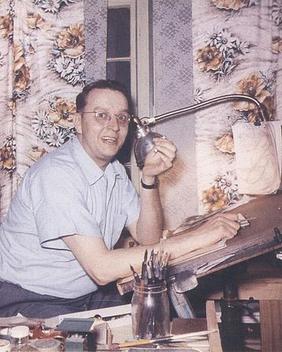
Jack Ralph Cole was an American cartoonist best known for birthing the comedic superhero Plastic Man, and his cartoons for Playboy magazine.
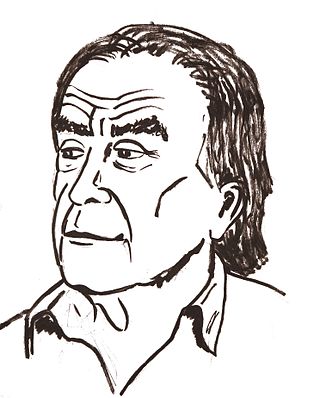
Gerald Anthony Scarfe is an English cartoonist and illustrator. He has worked as editorial cartoonist for The Sunday Times and illustrator for The New Yorker.
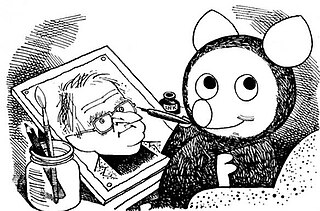
Walter Ernest Fawkes, also known as Trog when signing cartoons, was a Canadian-British jazz clarinettist and satirical cartoonist.

Hazel is a single-panel cartoon series by Ted Key about a live-in maid who works for a middle-class family. Launched in 1943, Hazel ended September 29, 2018.

King Features Syndicate, Inc. is an American content distribution and animation studio, consumer product licensing and print syndication company owned by Hearst Communications that distributes about 150 comic strips, newspaper columns, editorial cartoons, puzzles, and games to nearly 5,000 newspapers worldwide. King Features Syndicate also produces intellectual properties, develops new content and franchises, like The Cuphead Show!, which it produced with Netflix, and licenses its classic characters and properties.
The Washington Star, previously known as the Washington Star-News and the Washington Evening Star, was a daily afternoon newspaper published in Washington, D.C., between 1852 and 1981. The Sunday edition was known as the Sunday Star. The paper was renamed several times before becoming Washington Star by the late 1970s.

Ronald "Carl" Giles OBE, often referred to simply as Giles, was a cartoonist who worked for the British newspaper the Daily Express.

Don "Duck" Edwing was an American gag cartoonist whose work has appeared for years in Mad. His signature "Duck Edwing" was usually accompanied by a small picture of a duck, and duck calls were heard on his answering machine. Mad editor John Ficarra said, "He's exactly how people picture a Mad magazine writer." In 2007, Edwing told an interviewer, "I always believed that when you choose your field, you should specialize. You never deviate. I chose 'sick puppy'."

Sherrill David Robinson, known as Jerry Robinson, was an American comic book artist known for his work on DC Comics' Batman line of comics during the 1940s. He is best known as the co-creator of Robin and the Joker and for his work on behalf of creators' rights.

William Pierce Hoest was an American cartoonist best known as the creator of the gag panel series, The Lockhorns, distributed by King Features Syndicate to 500 newspapers in 23 countries, and Laugh Parade for Parade. He also created other syndicated strips and panels for King Features.

Henry Boltinoff was an American cartoonist who worked for both comic strips and comic books. He was a prolific cartoonist and drew many of the humor and filler strips that appeared in National Periodical comics from the 1940s through the 1960s.

Krazy Kat is an American newspaper comic strip, created by cartoonist George Herriman, which ran from 1913 to 1944. It first appeared in the New York Evening Journal, whose owner, William Randolph Hearst, was a major booster for the strip throughout its run. The characters had been introduced previously in a side strip with Herriman's earlier creation, The Dingbat Family. The phrase "Krazy Kat" originated there, said by the mouse by way of describing the cat. Set in a dreamlike portrayal of Herriman's vacation home of Coconino County, Arizona, KrazyKat's mixture of offbeat surrealism, innocent playfulness and poetic, idiosyncratic language has made it a favorite of comics aficionados and art critics for more than 80 years.

Freckles and his Friends is an American comic strip set in the peaceful small town of Shadyside where young Freckles McGoosey and his friends lived. Although the long-running strip, created by Merrill Blosser, is remembered for its continuing storyline involving a group of teenagers, it originally featured a child at the age of six or seven in gag-a-day situations.
Frank William Huline-Dickens was a British cartoonist, best known for his strip Bristow, which ran for 51 years in the Evening Standard and was syndicated internationally. According to Guinness World Records, Bristow was the longest running daily cartoon strip by a single author. The character Bristow is even one year older than that, as he debuted in Dickens' older series Oddbod in The Sunday Times in 1960. Due to his popularity, he received his own spin-off series soon afterwards. Dickens broke the original record held by Marc Sleen, whose The Adventures of Nero was drawn for 45 years without any assistance. However, even Dickens' record has been broken in his turn by Jim Russell, whose series The Potts ran for 62 years. Dickens received eight awards for "Strip Cartoonist of the Year" from the Cartoonists' Club of Great Britain.
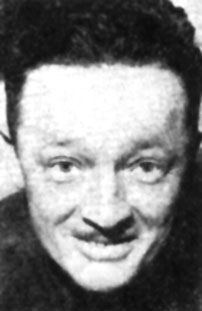
Merrill Blosser was an American cartoonist, the creator of the comic strip Freckles and His Friends, which had a long run (1915–1971). Although his strip was set in the small town of Shadyside, it was obviously based on Blosser's hometown of Nappanee, Indiana, since Blosser often referenced real Nappanee locations, such as Johnson's Drug Store.
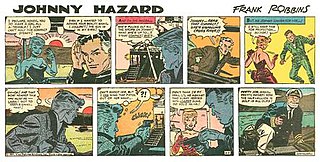
Johnny Hazard is an action-adventure comic strip created by cartoonist Frank Robbins for King Features Syndicate. It was published from June 5, 1944, until August 20, 1977, with separate storylines for the daily strip and the Sunday strip.
Comics journalism is a form of journalism that covers news or nonfiction events using the framework of comics, a combination of words and drawn images. Typically, sources are actual people featured in each story, and word balloons are actual quotes. The term "comics journalism" was coined by one of its most notable practitioners, Joe Sacco. Other terms for the practice include "graphic journalism," "comic strip journalism", "cartoon journalism", "cartoon reporting", "comics reportage", "journalistic comics", and "sketchbook reports".
Neville Maurice Colvin was a New Zealand-born cartoonist and illustrator. Dr Warren Feeney has referred to him as "alongside [David] Low [...] undoubtedly New Zealand's most famous international illustrator".
Wilfred Noel Uppadine Cook (1896–1981) was a New Zealand artist, illustrator, cartoonist and comics artist and a pioneer of science fiction comics. He worked in New Zealand, Australia and England.
References
- 1 2 3 "Peter Maddocks cartoonist and artist Malaga Costa del Sol and Worldwide". Maddocks. Archived from the original on 10 February 2012. Retrieved 11 January 2013.